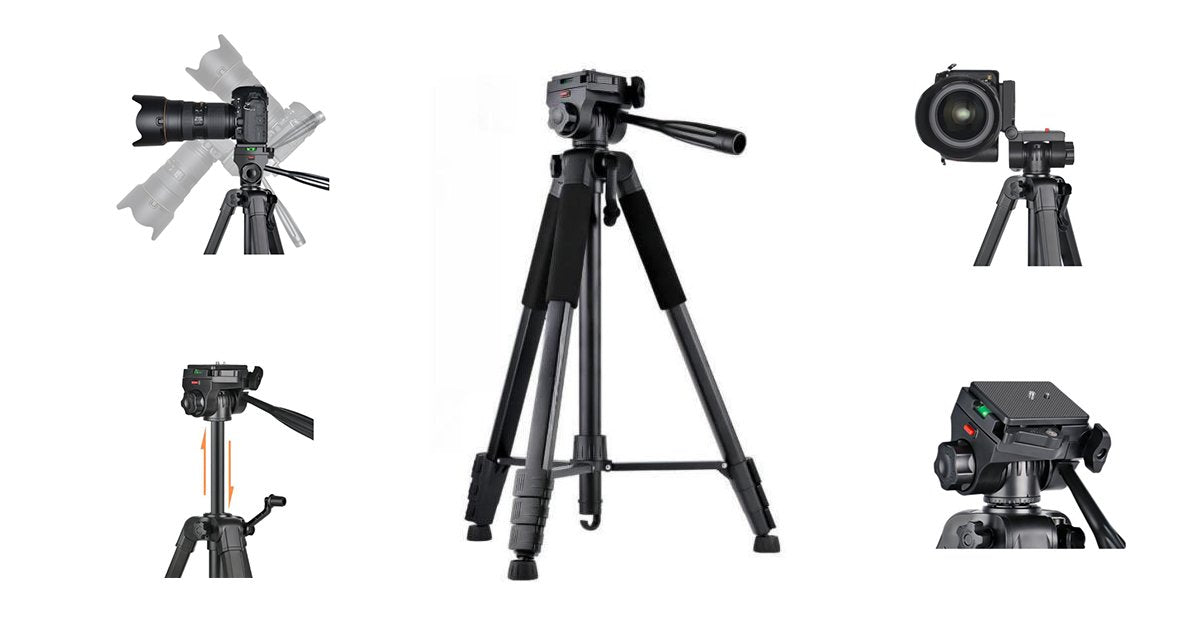A tripod is one of the most essential tools for photographers and videographers.
It helps you capture sharper images and more stable footage.
Whether you shoot stills, record dynamic videos, or live stream, the right tripod gives you control and confidence.
In this guide, we’ll show you how to choose the perfect tripod for your needs.

1. Understand Your Purpose: Photography or Videography?
Your content type determines which tripod suits you best.
For photography, stability is crucial for long exposures, landscapes, and macro shots.
For video, smooth panning and tilting are key to professional-looking footage.
Photography Tip: Choose a tripod that offers flexible height and adjustable angles.
Videography Tip: Use a tripod with a fluid head for smooth, cinematic movements.
2. Portability Matters: Lightweight vs. Heavy-Duty
Do you travel often or mostly shoot indoors?
If you move frequently, a lightweight tripod is best.
If you film in one place, choose a heavier tripod for more stability.
-
Lightweight tripods: Great for travel, vlogging, or everyday photography.
-
Heavy-duty tripods: Ideal for professional cameras and studio shooting.
View more options: Tripods & Stands
3. Consider Height Adjustability
Your shooting style affects the ideal tripod height.
If you shoot at eye level, pick a tripod that extends to that height.
For low-angle or macro shots, look for one that folds low or has a reversible center column.
Tip: Adjustable height helps you frame your subject perfectly.
ROODTUO tripods offer a wide range of height settings for every need.
See the full collection here.
4. Stability is Non-Negotiable
The main purpose of a tripod is to keep your shots steady.
A shaky tripod leads to blurry photos and unstable videos.
Look for thick legs and rubber feet for better grip on uneven ground.
5. Choose the Right Tripod Head
Different tripod heads serve different purposes:
-
Ball head: Quick and flexible, great for photography.
-
Pan-tilt head: Allows precise control for landscapes and architecture.
-
Fluid head: Designed for video shooting with smooth motion.
Many ROODTUO tripods support interchangeable heads, letting you switch styles easily.
Explore the full Tripod Heads Collection.

6. Load Capacity is Key
Make sure your tripod can handle your camera and any accessories.
If the setup is too heavy, the tripod might shake or even tip over.
Choose one with a load capacity higher than your total gear weight.
Pro Tip: Always leave extra margin for safety and smoother performance.
7. Extra Features for Convenience
Modern tripods come with practical extras that save time:
quick-release plates, bubble levels, hooks for counterweights, and compact folding designs.
These features make setup faster and more stable, especially outdoors.
Explore ROODTUO’s Tripod Collection
At ROODTUO, we design tripods for every creator — from beginners to professionals.
-
T60 Compact Tripod: Lightweight and portable, ideal for travel and vlogging.
-
T140 Compact Tripod: Adjustable height and strong stability for all-around use.
-
T175D Premium Tripod: Heavy-duty design for professional photography and videography.
-
T01 Tripod: A reliable all-rounder with excellent stability and compact size.
Browse all models: Tripods & Stands Collection

Conclusion
A tripod is more than just a camera stand — it’s the foundation of sharp photos and smooth videos.
Whether you need a compact travel tripod, a flexible daily option, or a professional-grade setup, ROODTUO has one made for you.
Start creating with confidence today.
Discover more: ROODTUO Tripod Collection
FAQ
Q1: Which ROODTUO tripod is best for beginners?
The T60 Compact Tripod is perfect for beginners. It’s simple, light, and easy to carry.
Q2: What’s special about the T140?
It offers flexible height adjustment and excellent stability for both photos and videos.
Q3: Can I use ROODTUO tripods for my phone?
Yes, all models can connect with smartphone clamps or adapters.
Q4: What’s the difference between tripods and tripod heads?
Tripods provide support, while tripod heads let you control movement precisely for photography or videography.


Share:
Why You Need a 3-Axis Stabilizer for Your Smartphone: A Guide to Smooth, Professional Video